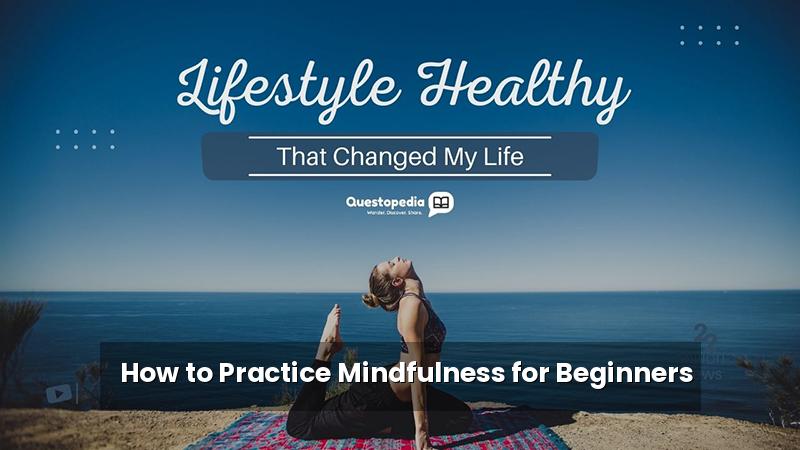How to Practice Mindfulness for Beginners
In today’s fast-paced world, it’s easy to get caught up in the whirlwind of daily life. Our minds race, thoughts multiply, and stress levels soar. Mindfulness offers a powerful antidote: a way to slow down, pay attention to the present moment, and cultivate a sense of calm amidst the chaos. This article will guide beginners through the foundational principles and practical techniques for incorporating mindfulness into their daily routines. Welcome to a more grounded and peaceful you!
What is Mindfulness?
At its core, mindfulness is the practice of intentionally focusing your attention on the present moment without judgment. It’s about observing your thoughts, feelings, and bodily sensations as they arise, without getting carried away by them. Think of it as being a curious observer of your own internal experience.
Benefits of Practicing Mindfulness
The benefits of mindfulness are numerous and well-documented. Regular practice can lead to:
- Reduced stress and anxiety
- Improved focus and concentration
- Better emotional regulation
- Increased self-awareness
- Enhanced sleep quality
- Improved relationships
These benefits stem from mindfulness’s ability to train your brain to be more present and less reactive. This can lead to a greater sense of well-being and resilience in the face of life’s challenges.
Getting Started with Mindfulness: Beginner Techniques
The good news is that mindfulness is accessible to everyone. You don’t need any special equipment or prior experience. Here are a few simple techniques to get you started:
1. Mindful Breathing
This is arguably the most fundamental mindfulness exercise. Find a comfortable position, either sitting or lying down. Close your eyes gently (or keep them softly focused on a point in front of you). Bring your attention to your breath. Notice the sensation of the air entering and leaving your body. You don’t need to change your breath in any way; simply observe it. When your mind wanders (and it will!), gently redirect your attention back to your breath. Start with just 5 minutes a day and gradually increase the duration as you become more comfortable. This article from Mindful.org offers more detailed instructions on mindful breathing.
2. Body Scan Meditation
A body scan meditation involves bringing your attention to different parts of your body, one at a time. Lying down is often the most comfortable position for this practice. Start by focusing on your toes, noticing any sensations you feel – pressure, tingling, warmth, or coolness. Then, gradually move your attention up your body, to your feet, ankles, calves, thighs, and so on, until you reach the top of your head. If you encounter any areas of tension or discomfort, simply acknowledge them without judgment. Again, if your mind wanders, gently bring it back to your body. Resources like guided meditations on apps like Headspace or Calm can be very helpful for this.
3. Mindful Walking
Mindfulness isn’t limited to sitting meditation. You can practice it while walking! Choose a quiet place where you can walk without distractions. Pay attention to the sensation of your feet making contact with the ground. Notice the movement of your body as you walk. Observe the sights, sounds, and smells around you. Avoid rushing; instead, walk at a comfortable pace and allow yourself to fully experience the present moment. Consider taking a walk in nature for an even more enriching experience. You can even practice mindful eating, which is discussed on questopedia.xyz.
4. Mindful Observation
Throughout your day, make an effort to simply observe your surroundings without judgment. For example, when washing dishes, pay attention to the feeling of the water on your hands, the smell of the soap, and the texture of the dishes. When waiting in line, notice the people around you, the sounds of the environment, and your own thoughts and feelings. The key is to be present and engaged with your experience.
Overcoming Challenges in Mindfulness Practice
It’s important to acknowledge that mindfulness practice isn’t always easy. Your mind will wander, you’ll feel frustrated at times, and you might even question whether it’s “working.” These are all normal experiences. Here are a few tips for overcoming common challenges:
- Be patient and kind to yourself: Mindfulness is a skill that takes time and practice. Don’t expect to become a master overnight.
- Start small: Even just a few minutes of daily practice can make a difference.
- Don’t judge your thoughts: Thoughts are just thoughts. Observe them without getting carried away by them.
- Find a quiet space: Minimizing distractions can help you stay focused.
- Consider using a guided meditation: Guided meditations can provide structure and support, especially for beginners. Apps like Calm and Headspace are great resources.
Making Mindfulness a Daily Habit
The key to reaping the benefits of mindfulness is to make it a consistent part of your daily routine. Here are a few tips for incorporating mindfulness into your everyday life:
- Schedule it: Treat mindfulness like any other important appointment. Schedule a specific time each day for your practice.
- Pair it with an existing habit: For example, you could practice mindful breathing for 5 minutes every morning after brushing your teeth.
- Use reminders: Set a reminder on your phone or computer to prompt you to practice mindfulness throughout the day.
- Be flexible: Life happens. If you miss a day, don’t beat yourself up about it. Just get back on track the next day.
Conclusion
Mindfulness is a powerful tool for cultivating inner peace, reducing stress, and improving overall well-being. While it may seem simple, the practice of paying attention to the present moment can have profound effects on your life. By incorporating the techniques outlined in this article into your daily routine, you can begin to experience the many benefits of mindfulness. Remember to be patient, kind to yourself, and persistent in your practice. The journey to a more mindful life is a rewarding one. Explore more about wellness and lifestyle on Questopedia.






